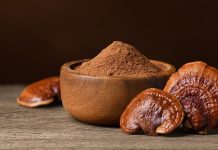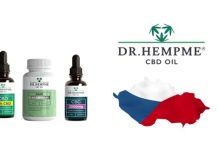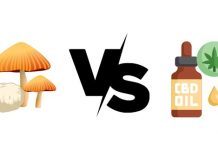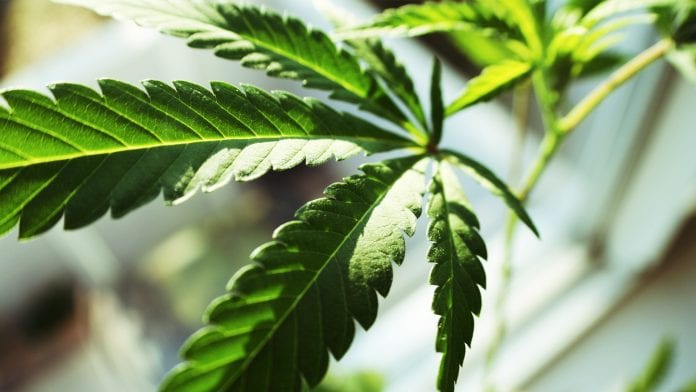
Leafcann Group Pty Ltd showcase the variety of delivery methods available and the importance of GMP certified products.
In today’s environment there is an abundance of medical cannabis products to treat a range of diseases and conditions. These products can be broken down into the delivery method of how they are administered to patients, which include but are not limited to:
- Oral administration of liquids – oils, tinctures and beverages containing medical cannabis;
- Oral administration of solids – specially formulated capsules/tablets, edible products, normal food containing medical cannabis powder or oil;
- Topical administration straight on to the skin – creams, balms, ointments, transdermal patches;
- Suppositories – typically by a specially formulated tablet or capsule;
- Inhalation – smoking dried flower, inhaling smoke from burning resin and vaporisers; and
- Insufflation – nasal sprays.
Did you know that LeafCann are Partners with Medical Cannabis Network? Learn more about our Partner and their extensive knowledge in natural alternatives to pharmaceutical medicines with cannabis ingredients.
There is no right or wrong way to take medicinal cannabis. Each method has its benefits and drawbacks. For some, the onset of relief is quick but does not last long while others come on slow and last much longer. Some affect the whole body, while others target specific areas.
At the heart of all medical cannabis products lies the issue of being able to deliver the correct dose to treat the condition or disease in question. The next most important thing to consider is the impact on a patient’s lifestyle and their ability to continue taking their medication reliably and effectively. A tablet containing a strong dose of THC may be convenient, but the dose may be so strong that it impairs driving or operating heavy machinery. However, being able to take much smaller doses over the course of a day may allow a normal quality of life while still deriving the benefits needed to treat a condition or disease. Time-release wafers, capsules or biofilms also offer benefits when wanting to delay the release of certain cannabinoids, while accelerating the delivery of others, to maximise patient outcomes.
Another consideration for choosing a delivery method for medicinal cannabis is the ‘first pass effect.’ This is the effect of enzymes in the liver breaking down cannabinoids such as CBD and THC before they reach the brain or other organs in the body, resulting in a smaller proportion of the original dose getting to where it should. Although the first pass effect is strongest through oral consumption, it still effects, although to a lesser extent, drugs taken through other routes such as buccal (absorption through the cheek), sublingual (under the tongue) or insufflation (blowing a vapour into the nose).
It is important to note that cannabinoids such as cannabidiol (CBD) and tetrahydrocannabinol (THC) are hydrophobic (they don’t mix well with water) and lipophilic (they easily mix with fats and oils). Therefore, it is very difficult to make water-based medicines containing cannabinoids. Some producers claim to have solved this through nano-encapsulation, but as yet none have completed randomised clinical trials to confirm this. In addition to this, cannabinoids are sensitive to light and oxygen, which is why doctors and pharmacists have traditionally stored them in sealed dark bottles.
Other limitations that influence product choices include the condition-dependent degradation of the acid forms THCA (tetrahydrocannabinolic acid) and CBDA (cannabidiolic acid), along with the varying shelf life of medical cannabis products, which depends on the interaction between the active ingredients and different carrier oils.
Dose titration and micro dosing
In the medicinal cannabis world, you will hear the cautionary advice ‘start low and go slow.’ This refers to starting on a low dosage, reviewing how that affects your body and mind and then determining whether you need to increase or decrease the dosage. In medical terms it is known as dose titration.
The ability to dose titrate is particularly important when taking medication such as THC. In consultation with a health professional, it is possible to incrementally find out what works best for a patient’s condition and lifestyle, but this takes time and a commitment from both doctor and patient.
Microdosing involves taking very small doses of a drug to obtain the positive benefits without incurring the negative side effects of a large dose. A micro dose can be as small as 1/20th of a normal dose. Microdosing works well with cannabis, where it can provide relief from anxiety and depression, allow a patient to have a sharp and clear focus and help with insomnia – all at very low doses.
One of the reasons microdosing works well with cannabis medicines is that the active cannabinoids work via both receptor mediated and off-receptor actions. The endocannabinoid system adjusts receptor number in target tissues according to processes that are not completely understood but appear to involve very small amounts of the active compounds ‘tuning’ receptor number and sensitivity.
Taking a closer look at the medical cannabis products
Capsules and tablets
Tablets and capsules (pills) are the quintessential pharmaceutical preparation. They represent exactness and precision of dosing. They are easy to transport, discreetly taken in public and generally have long lasting effects. However, tablets are also affected by first pass metabolism when taken orally, less so if used as a suppository or pessary.
Pills can take 45 minutes or longer for the active ingredient to enter your system, however, once onset of relief has started it lasts for several hours. Some capsules reportedly last for up to 8 hours. Pills may be hard to swallow for those with nausea symptoms and therefore not suitable for some. Pills are harder to dose titrate, particularly if looking for more immediate relief, as the onset of action takes time. If the dosage is not right, a patient may need to see their health practitioner and go through the whole process again.
Oils, tinctures and sublingual sprays, bio-films and buccal wafers
Oils are the most commonly produced form of medicinal cannabis. They are relatively easy to administer and titrate, simply by adding or subtracting more drops into your mouth or under your tongue, one drop at a time. The process of creating oils involves taking cannabis dried flower, extracting the cannabinoids and then typically adding a carrier oil which helps to contain the cannabinoids. Most medicinal cannabis manufacturers will initially extract their cannabinoids into an oil and send it off for further processing into final dose forms if necessary.
Sublingual administration involves placing drops under the tongue and holding for a minute to allow absorption of actives. This method works more quickly and effectively than ingested capsules or tablets. The onset of relief, when placed under the tongue, is within an hour and will last several hours. The difference between placing oil under the tongue rather than on top is that while sublingual (under the tongue) will be absorbed into the body via the bloodstream immediately, supralingual (on top of the tongue) will be swallowed and then digested, with the active ingredients eventually making their way to the intestines, broken down by enzymes and eventually be absorbed into the bloodstream, taking much longer.
Bio-films and buccal wafers act in a similar way to sublingual drops, being absorbed either under the tongue or via contact with the buccal mucosa at the top of the palate in the mouth. The added benefit of bio-films and wafers is dose control, taste and the ability to layer different active ingredients into layers within the bio-film or wafer, which allows different cannabinoids to be absorbed at different rates. This is especially useful where THC is needed for immediate acute pain relief.
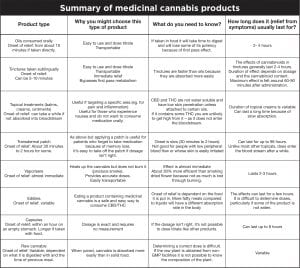
Tinctures are alcohol-based cannabis extracts and were the most common form of cannabis medicine early in the 20th century. In chemistry, a tincture is a solution that contains ethanol as its solvent, although tinctures may use other alcohol or
glycerol preparations.
Some patients opt to put drops of oil or tincture into drinks such as fruit smoothies or add it to their food. While this may make it easier for some, the problem is that it will take longer to work because the body must digest it first. It is always more effective to dose directly rather than place medicine in food.
Edibles and other food preparations
Edibles are any food item that contain cannabis. Placing medication in food has been discussed, however, there are now medical cannabis products on the market that are specially formulated medicines to be ingested as a food item on their own. They can come in forms such as soft jelly lollies, pastes and even butter. Edibles are usually high in fat, as this allows the cannabis to be infused more easily.
Beverages infused with cannabis are also making entries into the therapeutic market. However, as was mentioned earlier, cannabinoids do not mix easily with water. This should serve as warning to those wanting to consume products such as CBD water, which may have traces of CBD that are so small the only benefit the water may give is through simple hydration.
Edibles are useful in public situations such as in the workplace when discretion is preferred. Forms such as gummy bears, mints or chocolates can mask both the smell and taste of cannabinoids. As with any food medicines, the first pass effect means that it might take over an hour for the medicine to start working, although that is at a reduced rate because only some of the medicine has been absorbed.
All cannabis products consumed orally will have a whole of body effect. They are useful for conditions such as anxiety, insomnia, nausea, spasticity, tremors and overall pain, including arthritis. They are not as useful for conditions where a specific area needs to be targeted, such as pain in an elbow or knee. These conditions are better targeted with products such as transdermal patches or lotions.
Topical treatments including creams, ointments and transdermal patches
The advantage of topical treatments is that they can be applied directly to the affected area and focus the benefit there. One of the disadvantages of CBD and THC not being water soluble is they have low skin penetrability unless attached to certain types of carrier oils. This lack of penetration is useful however in cases where you do not want a topical with THC to enter the bloodstream where it can affect your whole body and get you ‘high,’ but instead work solely on a specific area.
The rate of absorption from creams and ointments is variable from product to product and person to person. Transdermal patches are different. Although most commonly associated with nicotine, transdermal patches are now used for a broad range of treatments, from motion sickness to contraception. Transdermal patches have the ability to slowly release cannabinoids into your body over a long period of time. Some of these patches are reported to last up to 96 hours. An added benefit is that if a patient isn’t happy with the treatment, they can simply take the patch off.
Vaporisers
Vaporisers can heat cannabinoids to a high temperature, but not so high that they burn the cannabis to produce smoke; nor do they have the odour associated with burning cannabis. The treatment itself provides relief in about five to ten minutes and lasts about two to four hours. Unlike normal smoking, vaporisers are able to deliver consistent doses into the lungs of known composition and consistency when using cartridges or oils produced under GMP conditions. As the recent vaporiser health crisis has shown, ensuring both the vaporiser and the cartridge of cannabis material have been produced by a licensed GMP producer is essential to safety.
Only trust GMP produced products
It is necessary to provide a warning about purchasing products from family, friends and other entities that are not GMP facilities. Home-made products, such as unprocessed oils, contain the same cannabinoids and the same ratios of cannabinoids (such as CBD to THC), and other chemicals like fertilisers and pesticides as the plants from which they are derived. Therefore, if the plant changes, or its growing environment changes, the composition of the oil will also change. You cannot be certain that every batch will be the same and this can lead to undesirable consequences. Not knowing the composition can impair your ability to work, drive or even stay awake.
Products made from hemp can also produce variability in composition unless processed in facilities that will ensure the medicine is exactly the same for every dose in every product line. Medicinal cannabis is a medicine and should only be prepared by professionals who can account for what is in the medication. Unlike professionally made products in GMP laboratories, non-pharmaceutically produced products cannot guarantee their content. Sometimes the producer may not know themselves.
What does the future hold?
There is a lot of opportunity for innovation in developing medical cannabis products. Patients will be looking for products with a variety of options that fit their needs. Many will look to products that work immediately and last a long time. This will involve novel ways of administration, including options such as nasal sprays which have the ability to be absorbed very quickly into the bloodstream or patches that might be able to lower or increase dosage automatically. Future products will need to offer long lasting effects as well as short lasting effects. They will need to be able to target specific areas and not others.
Patients of the future will want specially made, patient centred medications that are tailor made for them and their needs. The fact that the cannabis plant contains a large number of active cannabinoids, and other compounds such as terpenes and flavanols, suggests that it may be an excellent source of personalised precision medicines, but this represents significant technical challenges for the sector.
References
- Arafat, Mosab & Al-Hanbali, Othman & Sarfraz, Muhammad. (2018). Transdermal patches: Design and current approaches to painless drug delivery. Acta Pharmaceutica. 69. 1-19
- Baker D, Pryce G, Giovannoni G, Thompson AJ (May 2003). “The therapeutic potential of cannabis”. Lancet Neurol. 2 (5): 291–8
- Bruni N., Della Pepa C., Oliaro-Bosso S., Pessione E., Gastaldi D., Dosio F. Cannabinoid Delivery Systems for Pain and Inflammation Treatment. Molecules. 2018;23:2478
- Lewis M.A., Russo E.B., Smith K.M. Pharmacological Foundations of Cannabis Chemovars. Planta Med. 2018;84:225–233. doi: 10.1055/s-0043-122240
- Healthline.com website. Microdosing: smart psychedelics explained
- https://www.healthline.com/health/beginners-guide-to-microdosing#1
- University of Sydney. Lambert Initiative webpage: What products are available?
- https://sydney.edu.au/lambert/how-to-get-medicinal-cannabis/what-products-are-available.html
Elisabetta Faenza
CEO
Leafcann Group Pty Ltd
+61 414 447 275
ef@leafcann.com
www.leafcann.com.au
This article will appear in the first issue of Medical Cannabis Network which will be out in January. Click here to subscribe.





